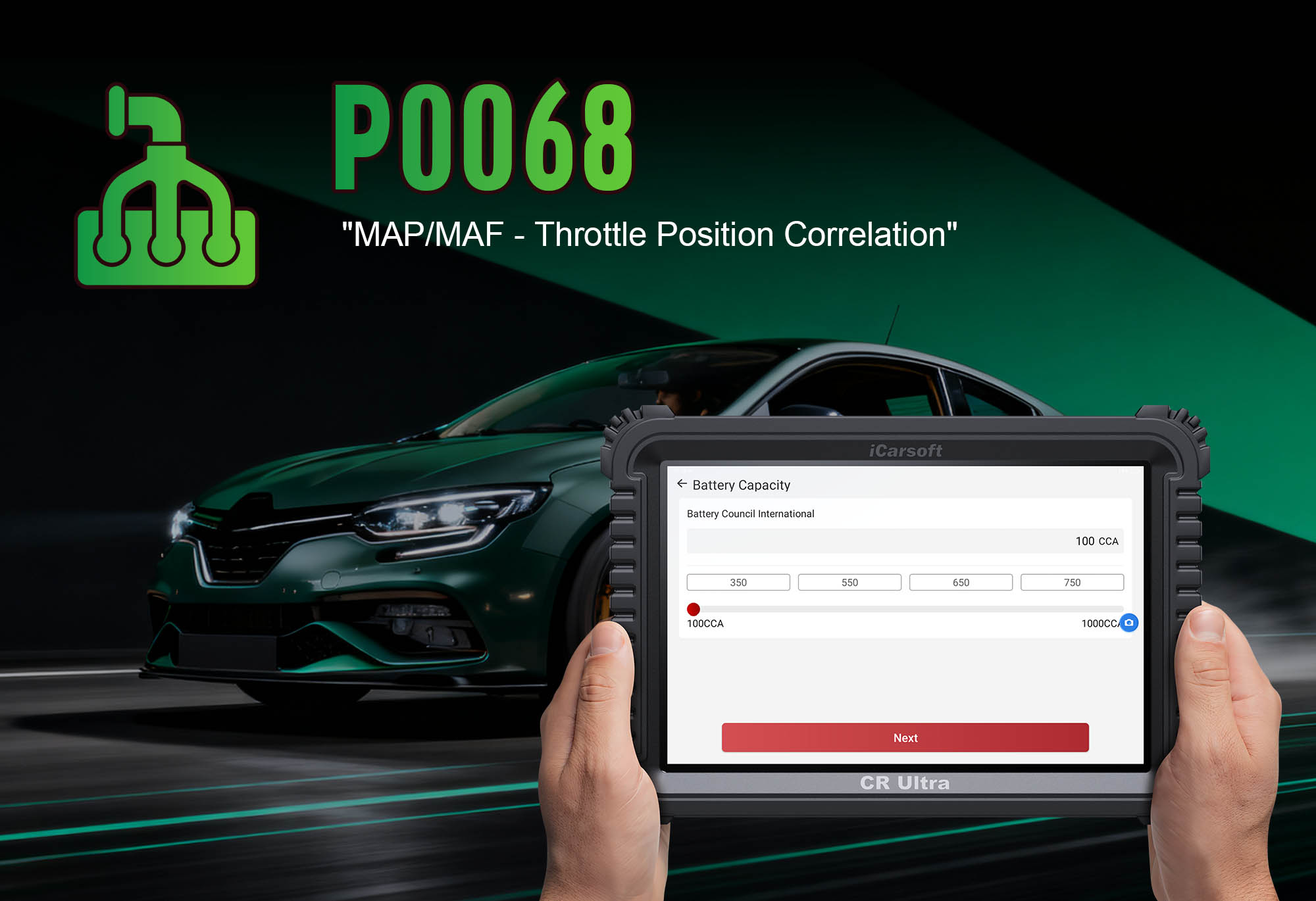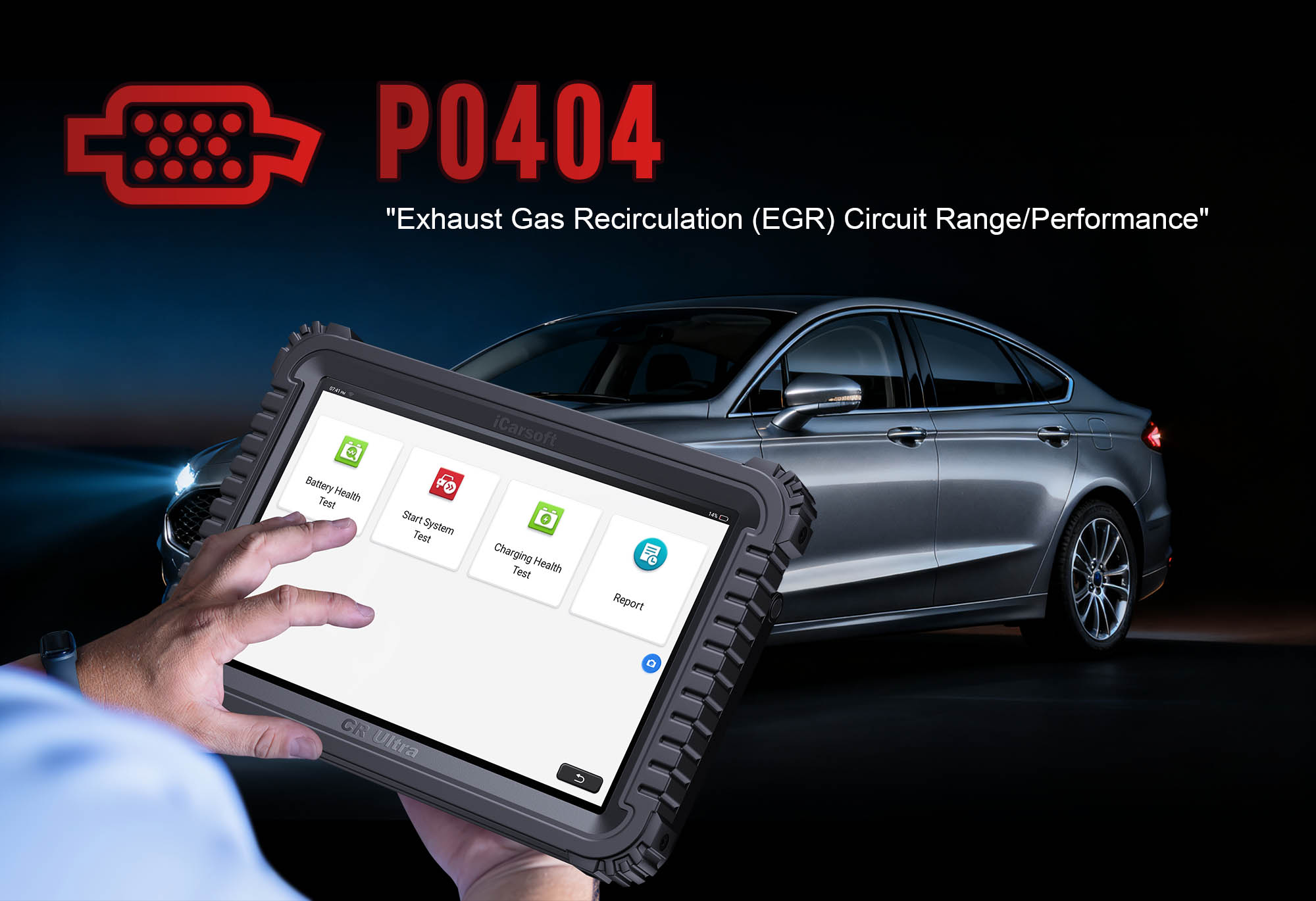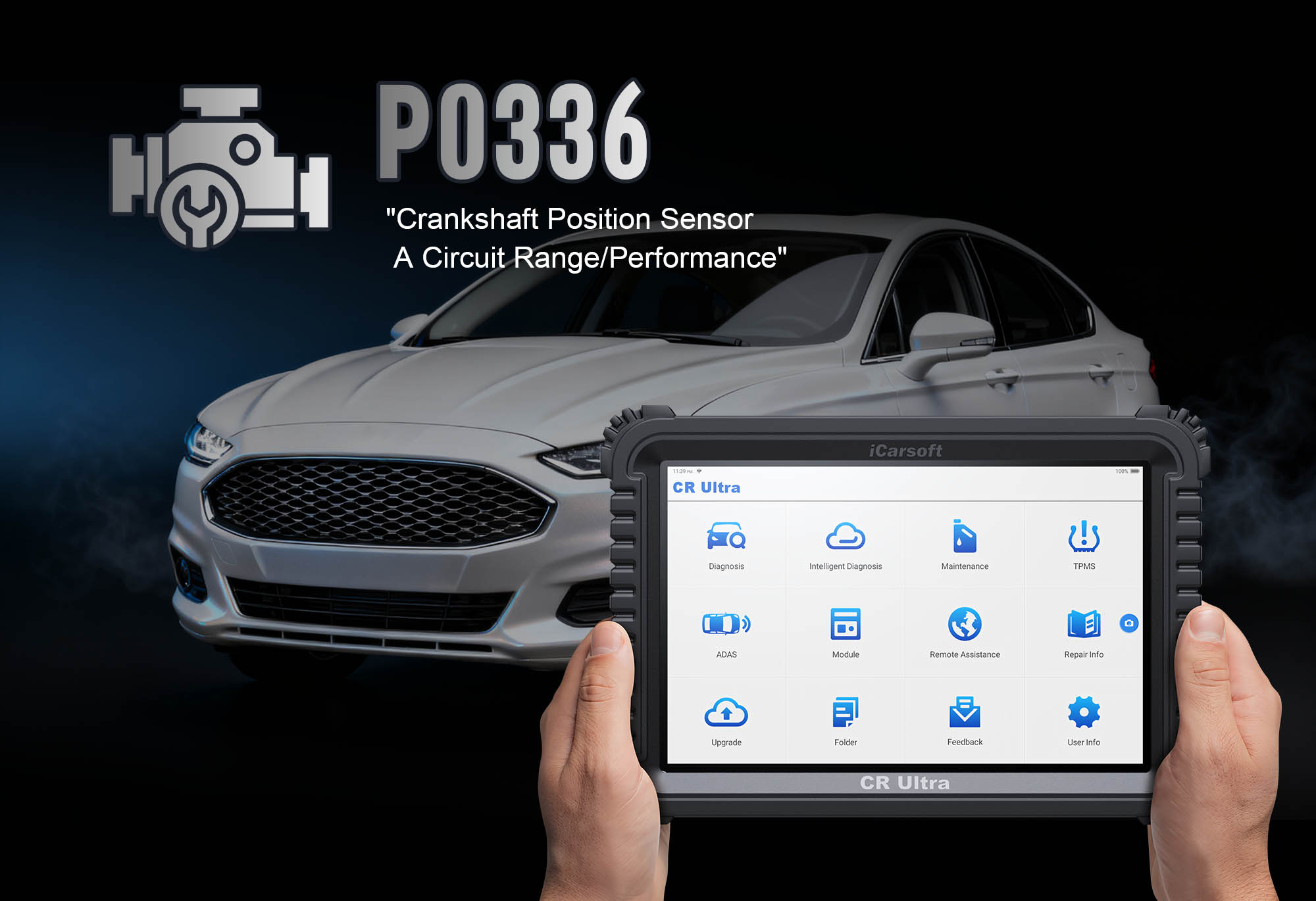Diagnose & Clear P0068 with iCarsoft CR Ultra: Fix Air Intake System Pressure - Regulation Error
If your check engine light illuminates and you experience poor acceleration, rough idle, or sudden stalling, a diagnostic scan will likely return P0068. This OBD-II code stands for "Air Intake System Pressure - Regulation Error," indicating the Engine Control Module (ECM) has detected a mismatch between the expected and actual pressure in the intake manifold.
The intake system relies on precise pressure regulation to optimize airflow into the engine, balancing the air-fuel mixture for efficient combustion. Key components like the throttle body, mass airflow (MAF) sensor, and manifold absolute pressure (MAP) sensor work together to maintain this balance. P0068 triggers when the ECM detects that intake pressure deviates significantly from the calculated value—often due to airflow restrictions, sensor faults, or throttle body issues. Left unaddressed, this can lead to reduced fuel efficiency, increased emissions, and engine damage from lean or rich conditions.
Basic scanners may only flag "intake pressure error" but can’t correlate sensor data or test throttle operation. The iCarsoft CR Ultra—with its advanced intake pressure analysis, live sensor correlation, and throttle body tests—solves this. Let’s explore how to diagnose and resolve P0068 using this professional-grade tool.
 iCarsoft CR Ultra: Analyzing intake system pressure to resolve P0068 regulation issues
iCarsoft CR Ultra: Analyzing intake system pressure to resolve P0068 regulation issues
Understanding P0068: Causes & Key Symptoms
An intake system pressure regulation error disrupts airflow dynamics, leading to distinct performance issues that affect power, efficiency, and reliability. Below are the critical symptoms to identify and common causes to target.
Key Symptoms of P0068
-
Check Engine Light: Illuminates when intake pressure deviates by ±25% from the ECM’s calculated value for 5+ seconds (varies by manufacturer).
-
Poor Acceleration: Restricted airflow or unregulated pressure limits the engine’s ability to draw in air, causing hesitation or lag when accelerating.
-
Rough Idle: An unstable air-fuel mixture—caused by pressure imbalances—leads to shaky or fluctuating idle speeds.
-
Stalling: Severe pressure mismatches can disrupt combustion entirely, causing the engine to shut off unexpectedly (especially at low speeds).
-
Increased Fuel Consumption: The ECM overcompensates for pressure errors by adjusting fuel delivery, lowering MPG by 10–15%.
-
Reduced Power: Limited airflow prevents the engine from reaching peak power output, noticeable during highway driving or heavy loads.
Common Causes of P0068
-
Clogged Air Filter or Intake Hose: Debris, dirt, or a collapsed hose restricts airflow, creating abnormal pressure in the intake manifold.
-
Faulty MAF or MAP Sensor: Inaccurate readings from these sensors mislead the ECM, causing incorrect pressure calculations.
-
Throttle Body Issues: A dirty, stuck, or malfunctioning throttle body fails to regulate airflow, disrupting pressure balance.
-
Vacuum Leaks: Unmetered air entering the intake manifold (via cracked hoses or loose gaskets) alters pressure readings.
-
EGR Valve Malfunction: A stuck-open EGR valve recirculates excessive exhaust gas into the intake, skewing pressure levels.
-
ECM Software Glitch: Outdated or corrupted firmware may miscalculate expected intake pressure (rare but fixable with updates).
Why iCarsoft CR Ultra Excels at Diagnosing P0068
The CR Ultra outperforms basic tools with specialized features for intake system diagnostics, ensuring you don’t just "detect the pressure error"—but isolate the exact component causing the mismatch.
Intake Pressure Correlation
Compares real-time MAP sensor readings to MAF data and throttle position, highlighting mismatches (e.g., "MAP = 18 psi, Calculated = 25 psi – 28% deviation"). Quantifies the error to prioritize fixes.
Throttle Body Function Tests
Uses bi-directional control to open/close the throttle, verifying if it responds accurately to ECM commands. Detects stuck or slow-moving throttles that disrupt pressure regulation.
Airflow Restriction Analysis
Measures airflow resistance through the intake system to identify clogged filters or collapsed hoses. Displays pressure drop values (e.g., ">3 psi drop = severe restriction").
3D Intake System Mapping
Displays high-resolution diagrams of the air filter, MAF/MAP sensors, throttle body, and vacuum lines for 200+ vehicle brands. Simplifies locating and inspecting critical components.
Vacuum Leak Detection
Integrates with smoke testing to pinpoint leaks in hoses, gaskets, or the intake manifold. Marks leak locations on the tool’s 3D map for precise repair.
Sensor Validation Suite
Tests MAF, MAP, and throttle position sensors against manufacturer specs. Distinguishes between sensor faults (e.g., "MAF reading 50% low") and mechanical issues (e.g., clogged filter).
Step-by-Step: Diagnose P0068 with iCarsoft CR Ultra
-
Connect & Confirm the Code
Plug the CR Ultra into your vehicle’s OBD-II port (use included adaptors for older models with non-standard ports). Power on the tool and select your vehicle via Auto VIN Scan (instant VIN reading) or manual entry (make/model/year/engine).
Navigate to Engine > Fault Codes > Read Codes to confirm P0068. Tap Code Details for vehicle-specific insights (e.g., "Ford: Intake Pressure = 16 psi (Target: 22 psi); Check Air Filter & Throttle Body").
-
Locate Intake System Components
Use the CR Ultra’s 3D mapping to avoid misidentifying critical parts (intake system designs vary by engine):
- Go to Component Location > Engine > Intake System > Pressure Regulation Components.
- The tool displays a 3D diagram highlighting:
-
Air Filter Housing: Located at the start of the intake tract (labeled "Air Filter"—common restriction point).
-
MAF Sensor: Positioned after the air filter, in the intake hose (measures incoming airflow).
-
MAP Sensor: Mounted directly on the intake manifold (reads manifold pressure in psi/kPa).
-
Throttle Body: Between the intake hose and manifold (controls airflow into the engine—marked with "TB").
-
Vacuum Hoses & EGR Valve: Connected to the intake manifold (common leak points, highlighted in yellow).
-
Analyze Live Intake Pressure & Sensor Data
Real-time data reveals the nature of the pressure mismatch—follow these steps for accurate diagnosis:
- Start the engine and let it reach operating temperature (10–15 minutes) to ensure stable sensor readings.
- In the CR Ultra, go to Engine > Live Data > Intake System and monitor four key parameters:
-
MAP Sensor Pressure: Actual intake manifold pressure (normal = 14–22 psi at idle, varies by engine size).
-
Calculated Intake Pressure: The ECM’s expected pressure, based on MAF airflow, throttle position, and RPM.
-
Pressure Deviation: The tool automatically calculates the difference (e.g., "-6 psi" = pressure too low; "+5 psi" = pressure too high).
-
MAF Airflow: Normal = 2–5 g/s at idle. Low readings = airflow restriction; abnormally high = vacuum leak.
-
Test for Airflow Restrictions
A clogged air filter or collapsed intake hose is a common, low-cost fix for P0068—verify with the CR Ultra:
-
Airflow Resistance Test: Navigate to Special Functions > Engine > Intake Tests > Airflow Restriction. The tool measures pressure drop across the entire intake system (from air filter to manifold).
- A drop >3 psi = significant restriction (first check the air filter—remove and inspect for dirt, debris, or oil contamination; replace if clogged).
- A drop >5 psi = collapsed intake hose (inspect the hose for kinks or soft spots that close under vacuum).
-
Intake Hose Inspection: Use the CR Ultra’s 3D map to trace the intake hose from the air filter to the throttle body. Squeeze the hose while the engine runs—if it collapses inward, replace it (collapses restrict airflow and alter pressure).
-
Diagnose Throttle Body & Sensor Function
A malfunctioning throttle body or faulty sensor is a top cause of pressure regulation errors—test with the CR Ultra:
-
Throttle Body Test:
- Go to Special Functions > Engine > Throttle Control > Adaptive Learning Reset to clear old throttle position data (resets the ECM’s baseline).
- Run the Throttle Activation Test: The tool commands the throttle to open to 20%, 50%, and 80% increments. Listen for smooth movement—binding, hesitation, or inconsistent response = dirty or stuck throttle body (clean with throttle body cleaner, following the tool’s step-by-step guide).
- After cleaning, re-run the activation test to confirm smooth operation.
-
Sensor Validation:
- MAF Sensor Test: Navigate to Special Functions > Engine > Sensor Tests > MAF Accuracy. The tool compares real-time MAF readings to expected values (e.g., "3.2 g/s at idle—normal" vs. "1.8 g/s—faulty sensor"). Replace the MAF sensor if readings are outside the manufacturer’s range.
- MAP Sensor Test: Select Special Functions > Engine > Sensor Tests > MAP Validation. Abnormal readings (e.g., 8 psi at idle when target is 18 psi) indicate a faulty MAP sensor—replace to restore accurate pressure data.
-
Check for Vacuum Leaks & EGR Issues
Unmetered air (vacuum leaks) or EGR malfunctions skew intake pressure—diagnose with the CR Ultra:
-
Vacuum Leak Detection:
- Go to Special Functions > Engine > Intake Tests > Smoke Test Setup.
- Connect a smoke machine to the intake manifold (use the tool’s guide to locate the test port—often the PCV valve or brake booster port).
- Start the smoke flow—leaks appear as smoke escaping from:
- Cracked vacuum hoses (common near the brake booster, PCV system, or EGR valve).
- Loose or damaged intake manifold gaskets (smoke seeps between the manifold and cylinder head).
- A faulty PCV valve (stuck open allows excess air into the manifold).
- Repair leaks with new hoses, gaskets, or a PCV valve (use the CR Ultra’s Part Lookup for compatible parts).
-
EGR Valve Test: Navigate to Special Functions > Engine > EGR Control > Activation Test. Command the EGR valve to open and close—if it’s stuck open, excess exhaust gas flows into the intake, disrupting pressure. Replace the EGR valve if it fails to respond to commands.
-
Repair & Clear P0068
Fix the root cause based on diagnostic findings (prioritize high-probability issues first):
- Replace a clogged air filter or damaged intake hose (use OEM or high-quality aftermarket parts).
- Clean or replace a dirty/stuck throttle body (follow the CR Ultra’s Throttle Cleaning Guide to avoid damaging components).
- Replace faulty MAF or MAP sensors (check the tool’s Part Lookup for vehicle-specific compatibility).
- Repair vacuum leaks with new hoses, gaskets, or a PCV valve.
- Replace a stuck-open EGR valve if tests confirm malfunction.
- Update ECM software: Use the CR Ultra’s Update Manager to check for and install firmware updates (resolves software-related pressure miscalculations).
- Clear the Code: In the tool, go to Engine > Fault Codes > Clear Codes to delete P0068.
-
Validate the Repair
Confirm intake pressure regulation is restored to prevent P0068 recurrence:
- Recheck live data—MAP sensor pressure should match the ECM’s calculated value within ±5% (no significant deviation).
- Test drive for 25–30 minutes, including:
- Low-speed idle (500–800 RPM) to verify stability.
- Acceleration from a stop to highway speeds (60–70 mph) to check for hesitation.
- Heavy-load conditions (e.g., uphill driving) to ensure consistent power.
- Re-scan with the CR Ultra after 2–3 drive cycles: No P0068 recurrence = successful repair. For long-term confidence, run the Intake Pressure Stability Test (under "Special Functions")—the tool monitors pressure for 10 minutes and provides a "Pass/Fail" result.
Preventing P0068 Recurrence
The CR Ultra helps maintain optimal intake system performance long-term, reducing the risk of P0068 returning. Use these proactive features:
-
Air Filter Maintenance: Set the tool’s Service Reminder to replace the air filter every 15,000–30,000 miles (sooner in dusty or off-road environments). The CR Ultra tracks filter life based on driving conditions.
-
Throttle Body Cleaning: Schedule annual cleaning using the CR Ultra’s Maintenance Alert. Carbon buildup on the throttle plate disrupts airflow over time—early cleaning prevents pressure errors.
-
Sensor Checks: Include MAF/MAP sensor validation in quarterly scans. The CR Ultra’s Sensor Health Report flags early inaccuracies (e.g., "MAF drift of 10%") before they trigger P0068.
-
Vacuum System Inspections: Use the CR Ultra’s Quick Scan monthly to monitor intake pressure deviation. Catch small leaks (e.g., "2 psi deviation") before they escalate to a full code.
Conclusion: Precision for Intake Pressure Regulation
P0068’s intake system pressure error is more than a check engine light—it’s a warning of disrupted airflow that harms performance and efficiency. The iCarsoft CR Ultra eliminates the guesswork of basic scanners, guiding you to the exact cause (whether a clogged filter, faulty sensor, or vacuum leak) with OE-level accuracy.
For DIYers, this tool prevents costly misrepairs (e.g., replacing a sensor when the issue is a $20 air filter). For professionals, it streamlines diagnostics and builds customer trust by fixing the problem right the first time. With the CR Ultra, resolving "intake system pressure" faults ensures your engine’s airflow remains optimized—delivering reliable power, better fuel economy, and lower emissions for every mile.

 iCarsoft CR Ultra: Analyzing intake system pressure to resolve P0068 regulation issues
iCarsoft CR Ultra: Analyzing intake system pressure to resolve P0068 regulation issues


